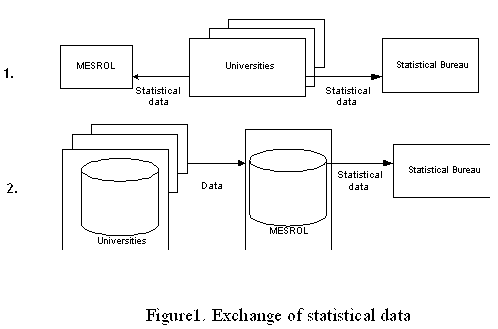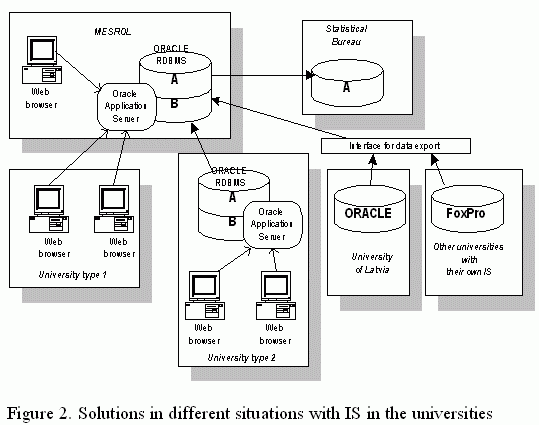Currently in Latvia information systems are used in some of the higher educational establishments only. Exchange of information among the universities, Ministry of Education and Science (MES) and State Statistical Bureau is in the form of Word documents or written papers. The obtaining of the full statistic data is burdened. Latvian Education Informatization project, a part of which is Information System of Higher Education (ISHE), enables to improve the present situation in Latvia. It is expected to develop a united classification of study programs and the register of programs and students. ISHE is developed in ORACLE, Internet browsers and Oracle WebServer being user's interface. The existing problems and solutions concerning the development of ISHE will be under discussion in this report.
The development of Information System of Higher Education (ISHE) in Latvia is bound up with development of Latvian Education Information System (LEIS) which was started in 1997 [1]. During the second stage of LEIS development (1.1.1998-31.12.1998) it was expected to develop ISHE to meet the needs of Higher Education and Science Department at Ministry of Education and Science of the Republic of Latvia (MESROL). During development process of ISHE the project team drew a conclusion that it will be necessary to set up a broader project, which will satisfy the needs of all involved users, such as establishments of higher education.
Before I explain the current situation with Information Systems in higher education establishments, it is essentially to spend a few minutes looking at some statistical characteristics of higher education in Latvia. In 1997 there were 18 state universities and 16 private institutions of higher education in Latvia. The total amount of students reaches as far as 64 200. Differentiation of universities according to the amount of students still continues: more than 54% of all students study in 3 larger universities (University of Latvia, Riga Technical University and Daugavpils Pedagogical University).
ISHE project team organized 3 seminars in which participated delegates from the universities. During the first seminar a questionnaire was presented and then filled by the delegates. We have received questionnaires from 20 universities. In the following conclusions there are not used answers from two largest universities. The questionnaire was composed of two parts:
All universities have Internet connections: leased lines - 8, dial-up connections - 5; the number of staff responsible for IS and technical support varies between 1 and 24. In the universities LAN is available mostly in all departments, faculties, etc. In some cases computers are only in Computer Centers. The number of computers varies between 12 and 188.
Concerning to the second part of questionnaire, the situation in the universities is following: currently in Latvia Information Systems are used in some universities only, mostly developed in Access or FoxPro; 7 universities have no IS at all; in 5 universities there are carried out some functions needed, but these universities are not satisfied with the current situation. The period of renewal of information is very different. It varies between once a year and every day. In most cases the IS are homemade products.
And at last, some information about IS of University of Latvia[2]. This Information System is developed in ORACLE environment, using Web browsers as user interface. The total amount of information is 300M. There are 60 000 records about students, 130 000 records about payments, etc. The users of this IS are from all faculties and other institutions of University of Latvia. There are more than 100 users at the moment.
As regards to the exchange of information among the universities, MESROL and State Statistical Bureau, it is in the form of Word documents and written papers. The obtaining of the full statistic data is burdened. The control over finances and credits of some individuals is impossible.
One of the most important questions is the exchange of statistical data.

Diagram I in figure 1 presents the existing situation in the exchange of data, but diagram II presents the way which will be possible in future after the implementation of ISHE.
The second important question is the development of a united classification of study programs in order to equalize the education system in Latvia to ISCED classification ratified by UNESCO.
In the 1st stage in 1998 it was expected to develop ISHE version 1 for the needs of MESROL. The diagram (Figure 2) presents 3 solutions which depends on IS in the universities.

The ORACLE RDBMS and Oracle Application Server were chosen because ISHE is a part of LEIS and these products were used in LEIS project for MESROL level Management IS.
In Figure 2 ORACLE RDBMS consists of 2 parts.
A: Data which meet Statistical Bureau's needs
B: Data which meet MESROL's needs and some specific data for universities.
Some specific data for universities were included in data model of ISHE because ISHE was planned for usage in both MESROL and universities where IS doesn't exist.
There exist 3 possible solutions for the universities (figure 2):
The solution 3 provides the possibility to change the database model and functionality, but it needs qualified staff with experience with ORACLE RDBMS.
The functionality of ISHE was planned according to the needs of MESROL. ISHE consists of 5 subsystems (figure 3).

Each of these subsystems ensures a possibility to search and view the information needed and update the existing information and add new data.
A great attention was turned to the possibility to create users of ISHE with a different access level depending on their university.
In the case when the university can work directly with the MESROL database, it is important to ensure the access for each university only to their data. Only one manager user must be created for each university. The manager is able to create database users for his university and grant different roles for the users with the user's management subsystem.
The student's subsystem includes information about students, personal data and education and study history.
The study programs subsystem ensure searching information about study programs,adding new study programs and updating existing study programs, courses of study programs.
On the second seminar the delegates from the universities were introduced with ISHE v.1. and were informed of the possible development in future. The participants agreed to inform the MESROL that their universities will participate in the further development of ISHE, version 2, which meets the needs of universities, or will not participate.
Mostly all universities agreed to be the participants of the further ISHE development (15 state universities and 4 private universities).
Now the project team is working with the universities to analyze the different study processes in the universities. The data model will be very similar with the existing model of IS of University of Latvia, but the functionality is different and this will be the most difficult point in the development of ISHE v.2.
The delegates from the University of Latvia every year participate in EUNIS (European Universities Information Systems) conference. It gives the possibility to gather information about situation in European universities. There were many attempts to develop a united IS in higher education in different countries (APOGEE in France, 4 different projects in UK etc.).
There is one important conclusion from experience of other projects in higher education: the projects should have a short life-cycle to deliver the greatest benefice and the greatest difficulty would be to bring about effective organizational change in the universities.
Maybe finally the project will not achieve the primary goal - implementing a new IS in all universities, but it certainly will achieve the goal to enlarge the cooperation between the universities.
University of Latvia
Raina boulv. 19, Riga, LV 1586, Latvia
e-mail: lnied@lanet.lv